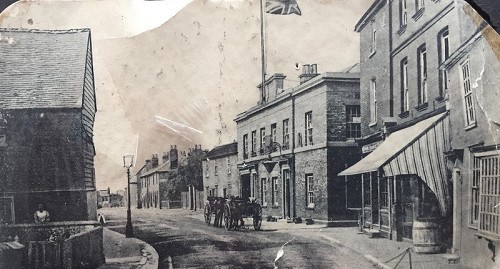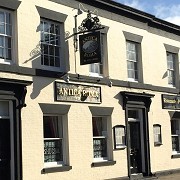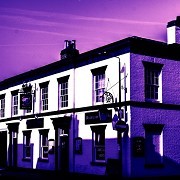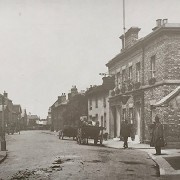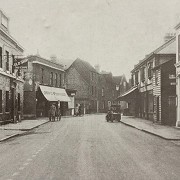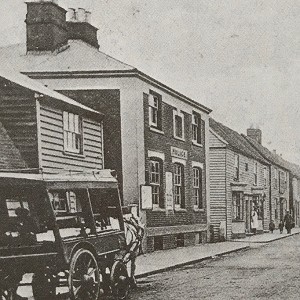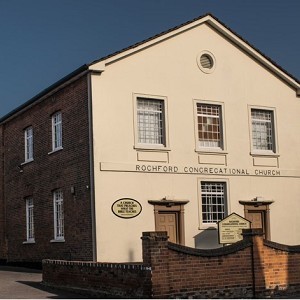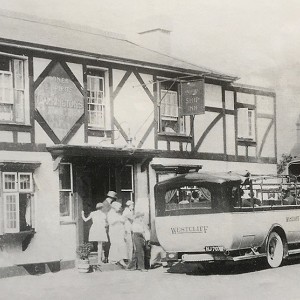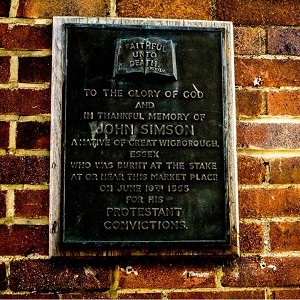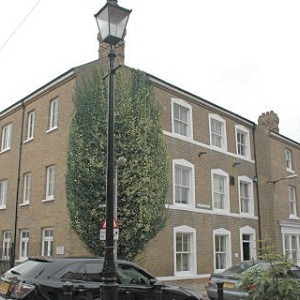History of Old Ship (HT)
This Grade II Listed Building is believed to date from the 17thcentury, but most of the features visible today date from the 18thand 19thcenturies. Before it became the Antica Roma Restaurant, it served briefly as the local Conservative Club. However for most of existence, from its origins right up to the 21stCentury, it was an inn, known as the Old Ship. Go around the corner into Old Ship Lane, walk past the building and look back and up. The original name of The Old Ship can still be seen high up on the gable.
Until relatively recent times, everyone drank beer rather than water. This was because beer having been boiled during its production was far safer than water, which probably teemed with harmful bacteria. They didn’t know it was the boiling that made it safe, they just knew that water made you ill, beer didn’t.
Beer therefore became the drink of choice from the 13thcentury onwards, right when Rochford was founded around the market. Originally there were alehouses which were just houses that made ale from malt, yeast and water and sold it in their front rooms. They either brewed it on the premises or sold ale that had been brewed elsewhere. Houses with cellars did better as ale kept longer in them
After 1450, more alcoholic beer made using hops starter to appear. A drink called small beer also appeared at this time. It was very weak in terms of alcohol content and this was the beverage commonly drunk instead of water, even by children, because it was safe. It could be sweet and porridge-like.
Alehouses provided basic food and may have offered cheap accommodation. They were establishments for the lower classes. Next up the ranks of hostelries were taverns. These were like modern restaurants providing good quality food and drink. Inns were the top rank establishments and were the equivalent of modern hotels. By the 16thcentury the distinction between alehouses, taverns and inns had become recognised in law.
Like many market towns, Rochford had far more inns, taverns and alehouses than its population needed. This was because the population would swell massively on market days and during fairs and all these visitors would need somewhere to eat, drink and stay.
The Old Ship fell into the category of an inn and was later known as a hotel, making it an upmarket establishment. This is further confirmed by the carriage arch, the carriage being the conveyance of choice for those that could afford them from the mid-18thcentury until the coming of the railways.
Although painted white at the front, it is made of high quality gault bricks with Flemish bond which is where each row of bricks has alternate headers (the end of the brick) and stretchers (the side of the brick) along it. This style was popular in the late 18thand early 19thcenturies. The sash windows seem to postdate the 1754 Building Act and the unpainted part at the back appears to be a slightly later extension.
The windows havesliding sashes with gauged brick arches.The front ground floor windows also still preserve the words, “Snug”, “Salon” and “Dining Room & Lounge”, echoes of its days as a pub. The two entrance doors havemoulded surrounds with a frieze and flat canopies of scroll brackets. Note the foot scrapers by both doorsteps, a reminder of when, before being surfaced and pavements laid, there would have just been mud.
Note also the elaborate cast iron scroll lamp bracket with the large black lamp hanging on it at the end of the building. This one hung on wires above the centre door.
Rochford, like many market towns, now has more pubs than can be sustained, but it’s good to see this building continues to serve the public as a restaurant.

